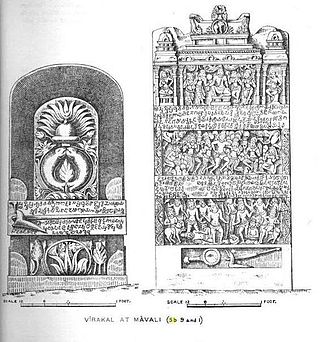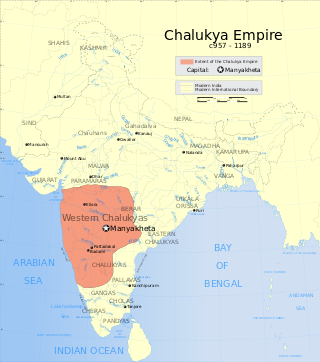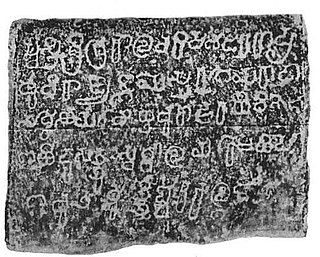Related Research Articles

Year 982 (CMLXXXII) was a common year starting on Sunday of the Julian calendar.

The middle kingdoms of India were the political entities in the Indian subcontinent from 230 BCE to 1206 CE. The period begins after the decline of the Maurya Empire and the corresponding rise of the Satavahana dynasty, starting with Simuka, from 230 BCE. The "middle" period lasted for almost 1436 years and ended in 1206 CE, with the rise of the Delhi Sultanate, founded in 1206, and the end of the Later Cholas.

Amoghavarsha I was the greatest emperor of the Rashtrakuta dynasty, and one of the most notable monarchs of Early Medieval India. His reign of 64 years is one of the longest precisely dated monarchical reigns on record. Many Kannada and Sanskrit scholars prospered during his rule, including the great Indian mathematician Mahaviracharya who wrote Ganita-sara-samgraha, Jinasena, Virasena, Shakatayan and Sri Vijaya.

Rashtrakuta was a royal Indian dynasty ruling large parts of the Indian subcontinent between the 6th and 10th centuries. The earliest known Rashtrakuta inscription is a 7th-century copper plate grant detailing their rule from Manapur, a city in Central or West India. Other ruling Rashtrakuta clans from the same period mentioned in inscriptions were the kings of Achalapur and the rulers of Kannauj. Several controversies exist regarding the origin of these early Rashtrakutas, their native homeland and their language.
The migrations of people and influences to the North from Karnataka during 7th-12th century period is well attested by the sources but has not yet been studied carefully. This is known as "The Great Karnataka expansion"

Govinda III was greatest Rashtrakuta monarch who succeeded his illustrious father Dhruva Dharavarsha. He was militarily the most successful emperor of the dynasty with successful conquests from Kanyakumari in the south to Kanyakubja in the north, from Banaras in the east to Bharuch in the west. From the Someshvara inscription of 804, it is known that 'Gamundabbe' was his chief queen.

Western Ganga was an important ruling dynasty of ancient Karnataka in India which lasted from about 350 to 1000 CE. They are known as "Western Gangas" to distinguish them from the Eastern Gangas who in later centuries ruled over Kalinga. The general belief is that the Western Gangas began their rule during a time when multiple native clans asserted their freedom due to the weakening of the Pallava empire in South India, a geo-political event sometimes attributed to the southern conquests of Samudra Gupta. The Western Ganga sovereignty lasted from about 350 to 550 CE, initially ruling from Kolar and later, moving their capital to Talakadu on the banks of the Kaveri River in modern Mysore district.

Dhruva was one of the most notable rulers of the Rashtrakuta Empire. He ascended the imperial throne after replacing his elder brother Govinda II. Govinda II had become unpopular among his subjects on account of his various misconducts as a monarch, including excessive indulgence in sensual pleasures. This according to the historian Kamath is evident from the Karhad plates of Krishna III. The Dhulia grant of 779 and Garugadahalli inscription of 782 proclaim Dhruva the emperor. Though some historians claim that Dhruva revolted and grabbed the throne, other historians feel the transition of the throne from Govinda II to Dhruva was peaceful and may have happened willingly. He earned titles like Kalivallabha, Srivallabha, Dharavarsha, Maharajadhiraja and Parameshvara.

Tailapa II, also known as Taila II and by his title Ahavamalla, was the founder of the Western Chalukya Empire in peninsular India. Tailapa claimed descent from the earlier imperial Chalukyas of Vatapi (Badami), and initially ruled as a Rashtrakuta vassal from the Tardavadi-1000 province in the present-day Vijayapura district of Karnataka. When the Rashtrakuta power declined following an invasion by the Paramara king Siyaka, Tailapa overthrew the Rashtrakuta emperor Karka II, and established a new dynasty.

The Western Chalukya Empire ruled most of the western Deccan, South India, between the 10th and 12th centuries. This Kannada-speaking dynasty is sometimes called the Kalyani Chalukya after its regal capital at Kalyani, today's Basavakalyan in the modern Bidar district of Karnataka state, and alternatively the Later Chalukya from its theoretical relationship to the 6th-century Chalukya dynasty of Badami. The dynasty is called Western Chalukyas to differentiate from the contemporaneous Eastern Chalukyas of Vengi, a separate dynasty. Before the rise of these Chalukyas, the Rashtrakuta Empire of Manyakheta controlled most of the Deccan Plateau and Central India for over two centuries. In 973, seeing confusion in the Rashtrakuta empire after a successful invasion of their capital by the ruler of the Paramara dynasty of Malwa, Tailapa II, a feudatory of the Rashtrakuta dynasty ruling from Bijapur region defeated his overlords and made Manyakheta his capital. The dynasty quickly rose to power and grew into an empire under Someshvara I who moved the capital to Kalyani.
The Origin of the Rashtrakuta dynasty has been a controversial topic and has been debated over the past decades by historians. The differing opinions mostly revolve around issues such as the home of the earliest ancestors of the medieval Rashtrakutas, a possible southern migration during the early part of the first millennium and the relationship between the several Rashtrakuta dynasties that ruled small kingdoms in northern and central India and the Deccan in the 6th century - 7th century. Further, the relationship of these medieval Rashtrakutas to the most important and famous dynasty, the Rashtrakutas of Manyakheta of the 8th century - 10th century time period has also been debated. Also contested is whether the Rashtrakutas of Manyakheta were related by ancestry to the early Kannada and Maratha communities of the Deccan or other ethnic groups of northern India.

Krishna I, an uncle of Dantidurga, took charge of the growing Rashtrakuta Empire by defeating the last Badami Chalukya emperor Kirtivarman II in 757. This is known from the copper plate grant of Emperor Govinda III of 807 and a copper plate grant of the Gujarat Rashtrakuta ruler Karka from Baroda. He is also known as Kannara or Kannesvara and took the titles Akalavarsha, Shubatunga, Prithvivallabha and Shrivallabha.He patronised the famous Jain logician Akalanka Bhatta, the author of Rajavartika.
Krishna II ascended the Rashtrakuta throne after the demise of his illustrious father Amoghavarsha I Nrupatunga. His Kannada name was Kannara. His queen was a Haihaya princess of Chedi called Mahadevi. From the chronology of inscriptions that mention the name of this emperor, it seems Krishna II may have started to rule even during the lifetime of his father. The fact that Amoghavarsha in his last years renounced the affairs of the state in dharmic pursuits supports this claim. The reign of emperor Krishna II saw significant advances in literature, although in the affairs of expansion of the empire, his reign was mixed. During his reign he cultivated matrimonial alliance with Chedis to form military gain.
Indra III was the grandson of Rashtrakuta Emperor Krishna II and son of Chedi princess Lakshmi. He ascended the imperial throne after the early demise of his father Jagattunga. He had many titles such as Nithyavarsha, Rattakandarapa, Rajamarathanda and Kirthinarayana. He patronised Kannada poet and commander Sri-Vijaya and Sanskrit poet Trivikrama. Indra III was married to princess Vijamba of the Kalachuri dynasty of central India (Chedi).
The History of Karnataka goes back several millennia. Several great empires and dynasties have ruled over Karnataka and have contributed greatly to the history, culture and development of Karnataka as well as the entire Indian subcontinent. The Chindaka Nagas of central India Gangas, Rashtrakutas of Manyakheta, Chalukyas of Vengi, Yadava Dynasty of Devagiri were all of Kannada origin who later took to encouraging local languages.
The political history of medieval Karnataka spans the 4th to the 16th centuries in Karnataka region of India. The medieval era spans several periods of time from the earliest native kingdoms and imperialism; the successful domination of the Gangetic plains in northern India and rivalry with the empires of Tamilakam over the Vengi region; and the domination of the southern Deccan and consolidation against Muslim invasion. The origins of the rise of the Karnataka region as an independent power date back to the fourth-century birth of the Kadamba Dynasty of Banavasi which was the earliest of the native rulers to conduct administration in the native language of Kannada in addition to the official Sanskrit.
Several Branches of the Rashtrakuta dynasty were created by the kings, commanders and relatives of the Rashtrakuta family during their expansion into central and northern India in the eighth to the tenth centuries. These kingdoms ruled during the reign of the parent empire or continued to rule for centuries after its fall or came to power much later. Well known among these were the Rashtrakutas of Gujarat (757-888), the Rattas of Saundatti (875-1230) in modern day Karnataka, the Rashtrakutas of Rajasthan and ruling from Hastikundi or Hathundi (893-996), Dahal, the Rathores of Mandore and Dhanop, Reddy dynasty of Andhra Pradesh and Telangana, Rashtraudha dynasty of Mayuragiri in modern day Maharashtra and Rashtrakutas of Kanauj.

The Tripartite Struggle, also known as The Kannauj Triangle Wars, for control of northern India took place in the ninth century, among the Gurjara-Pratihara Empire, the Pala Empire and the Rashtrakuta Empire.
The Nolamba dynasty the area they held sway over is referred to as Nolambasa-37 of Henjeru (Hemavathi), Nolambalige (Nolambavadi-32000), etc. R. Narasimhacharya states that the Nolambas were a native Kannada dynasty.
Marasimha II Satyavakya was a king of the Western Ganga Dynasty, 23rd in the succession. He was the successor of Marulaganga Neetimarga, his half-brother who reigned 961–963. He was succeeded by Rachamalla IV Satyavakya, his eldest son. He was a vassal of the declining Rashtrakuta empire and served them until their collapse.
References
- Kamath, Suryanath U. (2001) [1980]. A concise history of Karnataka : from pre-historic times to the present. Bangalore: Jupiter books. LCCN 80905179. OCLC 7796041.
- ↑ Settar, S. (1989). Inviting Death: Indian Attitude Towards the Ritual Death. Monographs and theoretical studies in sociology and anthropology. Vol. 28. BRILL. p. 21. ISBN 90-04-08790-7.